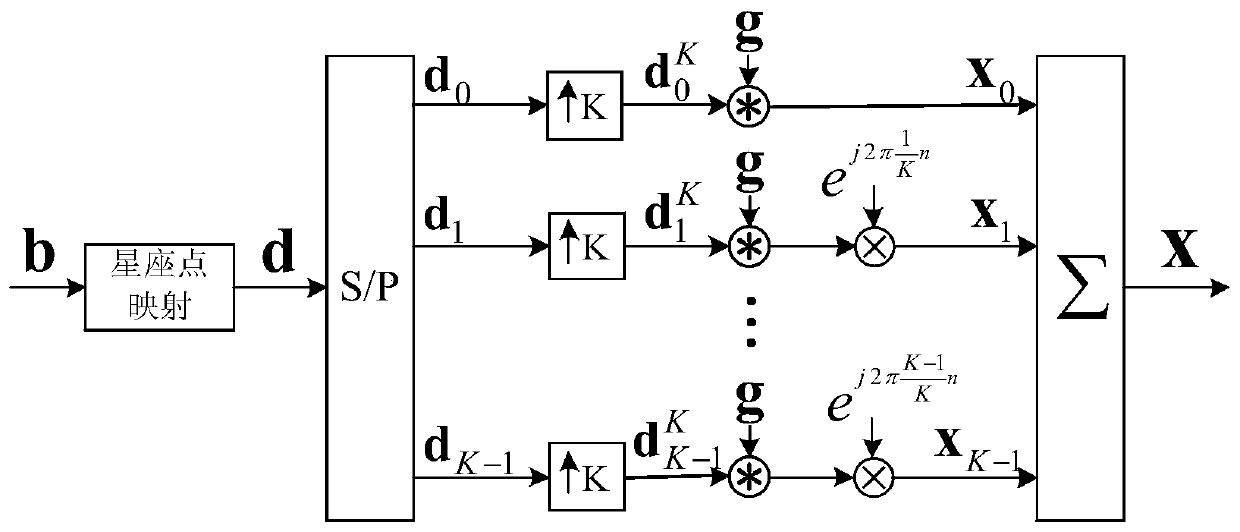gfdm system mmse receiving method and device suitable for fsc
A receiving method and technology of a receiving device are applied in the field of MMSE receiving method and device in a GFDM system, and can solve problems such as inapplicability of the AWGN channel model.
- Summary
- Abstract
- Description
- Claims
- Application Information
AI Technical Summary
Problems solved by technology
Method used
Image
Examples
Embodiment 1
[0040] A kind of GFDM system MMSE receiving method suitable for FSC, the method comprises the following steps:
[0041] 101: Using the sparsity and repeatability of the channel matrix and combining the transmit matrix, calculate the conjugate transpose matrix of the product of the channel matrix and the transmit matrix;
[0042] That is, the noise variance of the receiver is obtained by channel estimation and the channel matrix H of FSC, and then use the sparsity and repetition of the channel matrix to efficiently calculate the matrix B=(HA) * , where A is the GFDM transmit matrix, (·) * Represents the conjugate transpose.
[0043] 102: According to the quasi-tridiagonal arrangement structure of the expected matrix, the symmetric property about the diagonal, and the conjugate symmetric property about the inverse subdiagonal, combined with the conjugate transpose matrix, calculate the element values of each area of the expected matrix successively;
[0044] That is, fir...
Embodiment 2
[0052] The scheme in embodiment 1 is further introduced below in conjunction with specific calculation formulas and examples, see the following description for details:
[0053] 1. GFDM system model
[0054] 1. Transmitter model
[0055] Assume that the GFDM system model contains K subcarriers and M subsymbols. Such as figure 1 As shown, the binary source signal b of length N=KM is mapped to a QAM constellation to generate a complex sequence d of length N. After serial-to-parallel conversion, the complex sequence d is divided into K segments of length M where d k is the constellation point modulated onto the kth subcarrier, k is the subcarrier label, d k =[d k (0),...,d k (M-1)] T , d k (0),...,d k (M-1) is the M constellation points modulated onto the kth subcarrier, (·) T for the transpose. Then, each d k Do K-point upsampling to generate an upsampling sequence of length N Can be expressed as:
[0056]
[0057] Among them, δ(n) represents the unit impulse...
Embodiment 3
[0219] Below in conjunction with concrete experiment, the scheme in embodiment 1 and 2 is carried out feasibility verification, see the following description for details:
[0220] In this embodiment, the BER performance comparison between the original MMSE under the FSC and the MMSE receiving method proposed in the embodiment of the present invention is realized through experimental simulation. The FSC impulse response chosen for the experiment is Other parameters required for the experiment are shown in Table 2.
[0221] Table 2 Experimental parameter settings
[0222]
[0223] In this experiment, take E b / N 0 The range is [0,28]dB, for each E b / N 0 Point, conduct 1000 Monte-carlo simulations, each simulation uses 10 GFDM symbols. Figure 9 The BER performance curves of the two receivers are given. It can be seen from the figure that the BER curves of the two receivers are consistent, indicating that the low-complexity MMSE receiver proposed in the embodiment of ...
PUM
 Login to View More
Login to View More Abstract
Description
Claims
Application Information
 Login to View More
Login to View More - R&D
- Intellectual Property
- Life Sciences
- Materials
- Tech Scout
- Unparalleled Data Quality
- Higher Quality Content
- 60% Fewer Hallucinations
Browse by: Latest US Patents, China's latest patents, Technical Efficacy Thesaurus, Application Domain, Technology Topic, Popular Technical Reports.
© 2025 PatSnap. All rights reserved.Legal|Privacy policy|Modern Slavery Act Transparency Statement|Sitemap|About US| Contact US: help@patsnap.com



